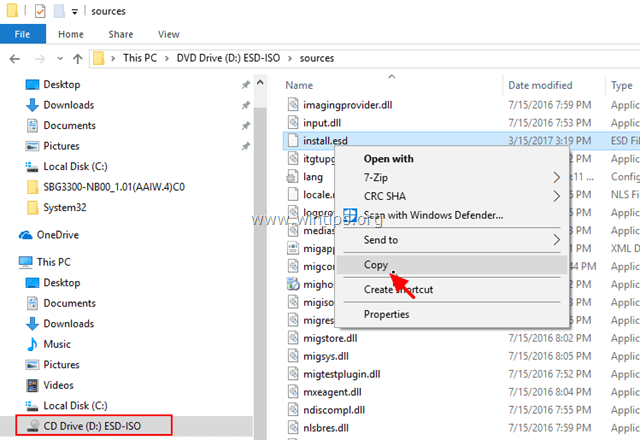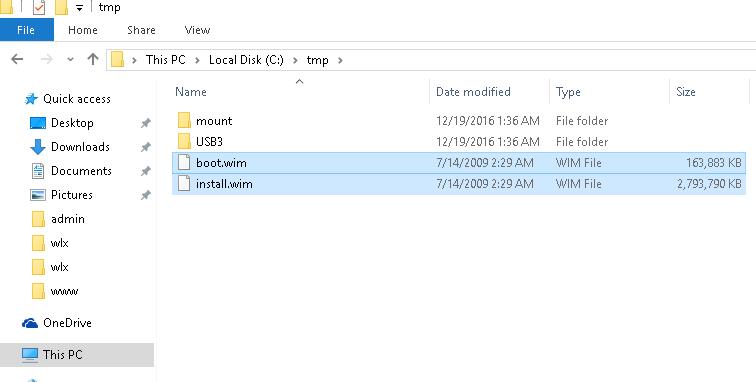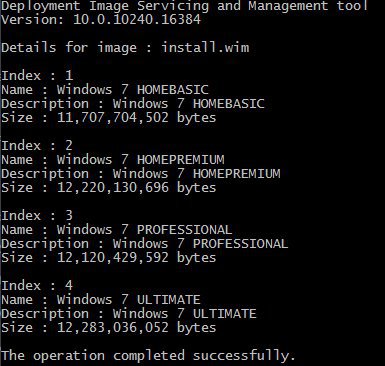Mar 31, 2018 Edit: Indeed, dism can be run from normal windows to clean install a dual boot version. So key steps:-Create an install.wim using @Kari's uuptoiso tool. Shrink C drive by say 50GB Create new partition in newly unallocated space Deploy image with dism from an admin command prompt Add boot entry from admin command prompt. Actually solved my issue. For me, my windows 7 install disk has both x86 and x64 versions of windows. When I applied the fix below to the boot.wim file, what I really needed to do was apply it to the bootx64.wim file (both are in the ‘source’ folder).
I was given an assigment to create a clean install of Windows 7, take a system image of it and make it a bootable image, so it can be booted from our local server. I've readed a few tutorials, but only one worked so far that it created a .wim . But when I transferred it to the server (Windows 2008 Server), navigated to Boot Images --> Add a new boot image
But it says it's not bootable. So how would I create a .wim that is good for the server from a 64bit Windows?
I have Windows AIK installed.
MDT Guy2 Answers
You can't create a boot.wim file from an install.wim. Boot.wim files are created with the Windows Automated Installation Kit. While a boot.wim file can be created from scratch using just the WAIK alone, you're better off using WAIK+MDT. Use the Microsoft Deployment Toolkit in conjuction with the WAIK tools to build a boot disc painlessly, as you're really not supposed to use WAIK all by itself.
Once you have a boot wim, use WDS to boot to the boot.wim, which will pull the install.wim from the deployment share you build in MDT 2013.
There is mass confusion on this issue all around, so please try to remember that boot.wims are created from the WAIK, and you use MDT to push the install.wims.
How to Use MDT 2013 to build a boot image to install Windows 7 from WDS
What Is A Wim File
Install MDT 2013 and ADK 8.1
Download & Install MDT 2013 Update 1 - http://www.microsoft.com/en-us/download/details.aspx?id=25175
Download ADK 8.1 - http://www.microsoft.com/en-us/download/details.aspx?id=5753
Create Deployment Share - http://www.youtube.com/watch?v=ciT_YqLdcgk
Import Drivers - http://www.youtube.com/watch?v=bWdGBVyD1pM
Upload boot image from MDT into WDS - http://www.youtube.com/watch?v=rZa6-pJn12M
It takes time, and some real work, but MDT is by far the best way to build boot.wim files. Build your install.wim files in a VM enviroment, they'll be 'hardware independent' and will run on everything regardless of make or model.
MDT GuyMDT GuyExtract Wim From Esd

A boot image is used to capture or deploy an image. OS images are INSTALL images. You cannot use WDS to 'boot' windows off the network and run it for the end user. If you need to load a boot image for capturing or deployment of images, get a Windows 7 or Server 2008 R2 (or if you have access, Windows 8 or Windows 2012 Server) DVD and use the boot image from there. Once the boot image is loaded (that boot image will execute setup and allow you to deploy your install image) you can create a capture image by simply right clicking the boot image in the WDS management tool and selecting 'Create Capture Image' - once created you need to add it to WDS th
Capture a Windows image (.WIM) file and use it to deploy Windows to new devices.
You can start with either the install.wim file from a Windows distribution ISO, or you can generalize and capture a running Windows image into a .WIM file.
Win 7 Install.wim Download

WIM files only capture a single partition. You can usually capture just the Windows partition, and then use files from that image to set up the rest of the partitions on the drive. If you've created a custom partition configuration, see Capture and Apply Windows, System, and Recovery Partitions.

Capture the image**
If you've booted into Windows, generalize the image so that it can be deployed to other devices. For more information, see Sysprep (Generalize) a Windows installation.
Boot the device using Windows PE.
Capture the Windows partition. For example:
Where D: is a USB flash drive or other file storage location.
Windows 7 Install.wim File Download
Apply the image
Boot the device using Windows PE.
Wipe the hard drive and set up new hard disk partitions using a script. Use CreatePartitions-UEFI.txt (or CreatePartitions-BIOS.txt for older, legacy BIOS devices).
Apply the images using a script.
Sample script: